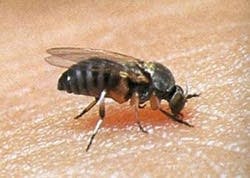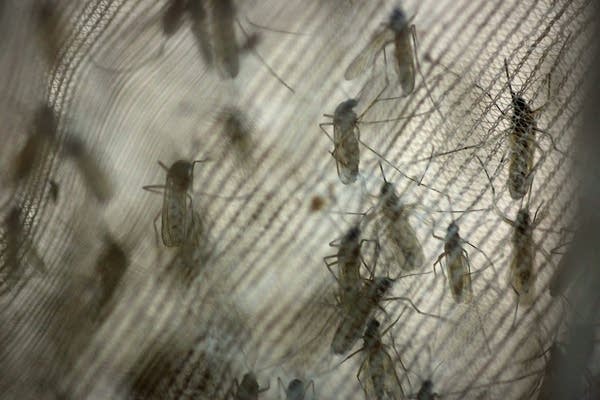Summer bummers: 9 things that can ruin fun and how to fight back

As spring turns to summer there's a lot to be excited about. Bike rides, picnics and beach visits — many Minnesotans are already out exploring nature and soaking up the sun.
But summer has a dark side. From pests to sunburn to poison plants, here's a look at some of the bummers summer brings with it, but also, how to fight back!
1) Attack of the buffalo gnats

You may have noticed more company on your morning walk. Those buzzing bothers flying into your face are buffalo gnats, also known as black flies. While these gnats don't carry any diseases that can transmit to humans, Minnesotans have experienced the annoyance of an especially large gnat population this season.
Create a More Connected Minnesota
MPR News is your trusted resource for the news you need. With your support, MPR News brings accessible, courageous journalism and authentic conversation to everyone - free of paywalls and barriers. Your gift makes a difference.
Minnesota's clean and abundant water is good for buffalo gnats. Their larvae hatch in it and they filter feed from water, too. Plus, widespread flooding across Minnesota has made treatment difficult in many areas.
But fear not — gnats have a short life cycle and even a windy day can help clear them from the air. Mosquito repellent works on these pests, too; you just have to be diligent as they're better at finding spots you missed.
2) The scourge of the mosquito

Ahh, summer's most pesky pest. There are 51 species of mosquito in Minnesota and they can be grouped into two categories: spring and summer species. Like gnats, mosquitoes lay their eggs in wet areas — laying eggs on the ground at water level, where pools form when it rains.
Making Minnesota a great place to live — for them.
You've probably heard it before, but we'll say it again: to avoid getting bit this summer wear a repellent containing DEET. You can also wear lighter colors, keep your skin covered and avoid going out at night when the bloodsuckers are most active. Find more tips here.
3) And then there's ticks

You'd think the harsh winter would've thinned the herd. Think again.
Low temperatures only kill ticks if they're exposed to the frigid air, and the snow earlier this year actually provided a nice blanket to keep ticks insulated from the bitter cold.
The tips for fighting back are similar to other tiny biters — wear repellents that contain DEET, keep your skin covered — especially your feet and ankles as ticks typically hitch a ride from the grass you're walking through.
With Lyme disease on the rise in Minnesota, you'll also want to check your body for ticks and tick bites after a day of fun outdoors. Typically, it takes about 24 hours for a tick to infect someone after it starts biting. You can find more on how to protect yourself and recognize symptoms here.
4) Orange cone season
Deep breaths. Deep cleansing breaths.

There are hundreds of projects planned for Minnesota's roads and bridges this year with the Minnesota Department of Transportation unveiling over 200 projects earlier this spring. You can find a full list of the current projects on their website here.
We'll also be posting a roundup of weekend travel woes on our site throughout the summer.
So, check out MnDOT's plans, plan ahead and maybe download a podcast or two so your time stuck in traffic is still well spent!
5) Who turned up the heat?

We're approaching the hottest months of the year, and while that's very exciting for some, remember not to overdo it.
Usually on extremely hot days health officials send out warnings for the elderly and very young, but a recent study found that it's teens and young adults, especially young men, who end up in the emergency room.
Researchers did not determine exactly why this cohort is most likely to turn up overheated in the ER. But it's likely because they're working outdoors in the summer or playing sports.
So, no matter how much fun you're having, make sure you're staying hydrated, find some shade every now and then and avoid overexertion.
6) Feel the burn

Protecting yourself from sunburns isn't just about preventing painful, flaky skin, it's about guarding against skin cancer. So before you leave the house to have your fun, put on that sunscreen!
And it's not a one-and-done kind of deal. Check the sun protection factor (SPF) on whatever sunscreen you're using.
"SPF basically measures how long you can be outdoors before getting a burn," dermatologist Dr. Anudeep Rahil told MPR News in a previous report. "SPF just reflects the UVB radiation, it doesn't take into account the UVA radiation. If something says SPF 15, it means that you can stay outside 15 times longer before burning."
Check out more about why we sunburn and how sunscreen helps here.
7) Bowwows beware blue-green algae

Across Minnesota each summer, sky-blue waters transform into pea-green soup, a sign of possible toxins.
Human sickness and death related to toxic algae is rare, and the blooms aren't always toxic. But reports of algae illnesses and deaths in dogs have become more common. In the summer of 2014 the state recorded its first two cases of human illness. You can read some of our in-depth reporting on the algae here.
• Full coverage: Enjoy all the outdoors has to offer in Minnesota
• Check out what other Minnesotans are up to
• Share your own adventures!
For humans, wash the affected area if you think you've come in contact with toxic algae. It can cause a rash or skin irritation if you touch it, and diarrhea, cramps and nausea, tingling and dizziness if you ingest it. Watch for those symptoms!
Dog owners will want to follow these steps for keeping their furry friends safe while playing near ponds, lakes and rivers this summer.
• Watch the water. Toxic blooms often look like thick pea soup or green paint floating on the surface of the water. Keep an eye out for smelly, floating mats of scum.
• If you think your dog has come into contact, wash them well. That's particularly important for keeping the animal from swallowing algae when it licks its fur.
• Watch for the symptoms which include drooling, vomiting, diarrhea, tremors, seizures, refusing to eat and yellow gums. If your dog shows any signs of such poisoning, immediately call a veterinarian or animal poison control line.
8) Poison ivy: Look so you don't touch!

Among a hiker's (and Batman's) worst enemies: poison ivy is a lurking danger in the summer. A red, streaky, itchy rash can form days or even weeks after coming into contact with your bare skin.
When it comes to combating these dastardly plants, avoiding them is first on your to-do list. You may have heard the saying "leaves of three, let it be," and that's a good rule to follow — but poison ivy can grow in many shapes and sizes.
You're safe if the plant you see has thorns, but not if it has berries, and vines that grow up trees can even mimic the shape of their host.
If you believe you've come into contact and a rash forms, treat it with anti-itch or corticosteroid cream. If the rash gets worse, or if it's in a sensitive area, see a doctor right away.
Unlike the algae, you don't need to worry about your dogs, they're not allergic. Just be careful petting them if you saw them barrel through some poison ivy while on your last walk.
9) Loving your favorite scenic view to death

In this case it is you who is the bummer. Outdoors advocates say the way some social media users share their adventures online is hastening the deterioration of scenic spaces around the world.
Exploring the outdoors is great, but too much foot traffic and any waste left by visitors can be detrimental to your favorite trail or outlook. The key is being a responsible visitor. Here are some suggestions from the Leave No Trace Center For Outdoor Ethics:
• "Tag thoughtfully": This means avoid giving specific location information for a picture.
• "Be mindful of what your images portray": For example, don't show anything that would encourage poor behavior in the outdoors.
• "Give back to places you love": Volunteer for conservation work, Leave No Trace says.
• "Encourage and inspire Leave No Trace in social media posts": Consider how a post could be used to educate people about conservation.
Looking for more news from the outdoors? Check out our full coverage here and download our Outside in MN app where you'll find guides, outdoor events near you and weather updates. Get it on Apple or Android stores.